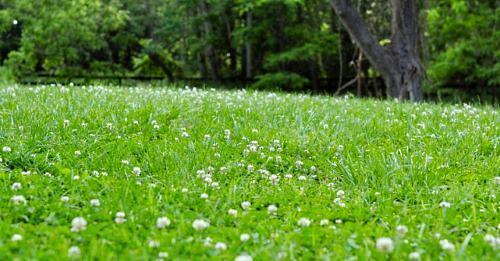How to create a white clover lawn in the sand?
White clover is often used to create flowering green lawns as an alternative to traditional grasses that grow well and form a beautiful carpet in not all soil types.

Benefits of white clover
Clovercertainly outperforms other lawn grasses, although it is not a material for creating classic lawns. However, it is worth exploring its positive qualities.
Unpretentiousness
This plant thrives on all types of soil, making it easy to create a white clover lawn on the sand. In addition, when planting on denser soils, it is recommended to pour a few centimeters of sand before sowing.
Aesthetics
In appearance, such a lawn is not inferior to a traditional lawn. The triple leaves look delicate and decorative, and the high growth rate and high plant density allows you to completely cover the soil surface. Such a lawn looks especially elegant during flowering, when it is covered with small white flowers that attract bees and butterflies. There are also ornamental varieties with unusual leaf colors, such as 'Dragons Blood' or 'Purpurascens Quadrifolium'.
Softness and resistance to stress
Trample-resistant grass lawns are usually too tough, and soft grass mixtures do not hold up. Clover lawn combines softness and durability. It is very pleasant to walk on such a lawn barefoot, play with children and just lie around while sunbathing.
Unpretentiousness, minimal maintenance, the ability to avoid or reduce the number of haircuts, and the aroma of a flowering lawn for many make this coverage an ideal lawn. It easily restores its former appearance even after intense children's play, which is very important when creating small children's playgrounds in the garden.
Soil enrichment
White clover is good because it is able to grow on poor sandy soils. At the same time, there is no need to apply fertilizers, since clover, like all members of the legume family, is able to fix atmospheric nitrogen and transfer it into the soil, which is accessible to other plants.
Taking care of pets
Small rodents, which are often bought by children (hamsters, guinea pigs, decorative rabbits) will be grateful for such a green corner. They will gladly feast on juicy tasty leaves.
Features of growing a lawn from clover
Clover seeds germinate well only if certain sowing conditions are met:
- Firstly, a large amount of moisture is needed for germination, therefore, before or immediately after sowing, it is necessary to water the area and keep it moist until shoots appear. Moisture levels are especially important on sandy soils, which are water permeable and dry out quickly. Some experts even recommend covering the soil with agrofibre at first to maintain the required moisture level. Sowing is best done before the rain.
- Secondly, the seeds germinate well only when the soil warms up to 15 ° C.With earlier sowing, seeds can lie in the ground for 3 weeks or more, waiting for warmth. Therefore, the best time to plant a clover lawn is considered May, when there is still enough moisture in the soil and the temperature has reached the right temperature for rapid germination.
- Thirdly, for a normal uniform distribution of seeds, they are recommended to be mixed with sand, since the seeds are small enough and it will be difficult to observe the required seeding rate and at the same time it will be difficult to evenly distribute them over the soil surface.
The disadvantages of white clover are also worth mentioning:
- The plant is quite aggressive and quickly occupies free areas, so its growth will have to be constantly limited.
- Flowers attract bees and if you play or walk barefoot on the lawn, you are likely to step on the bee. Therefore, in such areas, you will have to prevent flowering.
- After mowing, the clover lawn looks very unattractive, but the decorative effect is restored after 5-7 days.